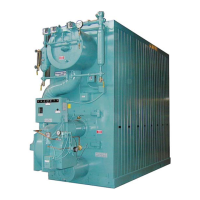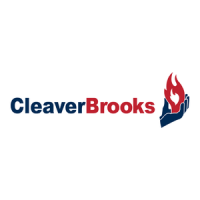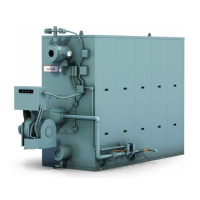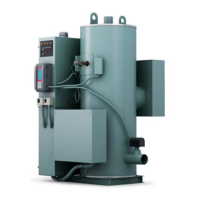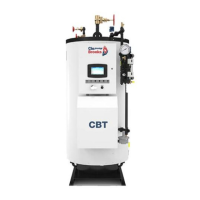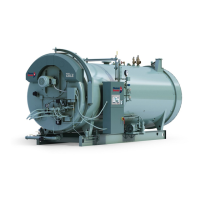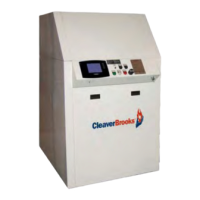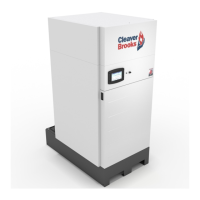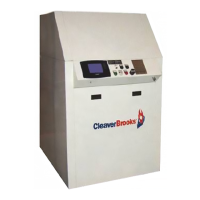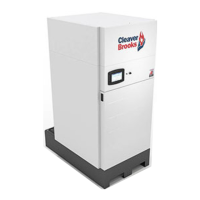STARTING AND OPERATING INSTRUCTIONS Chapter 5
750-177 5-7
AIR AND FUEL CONTROLS
(DESCRIPTION)
The combustion system air and fuel controls have been
factory adjusted, and the unit has been test fired before it was
shipped. Regardless of preliminary adjustment and operation,
it is necessary to readjust the controls for local conditions:
• The fuel flow controls must be adjusted to establish the
rated heat input over the full range of firing-rate modula
-
tion.
• The air controls need to be adjusted, relative to the es-
tablished fuel flow rates, to provide the correct amount of
air for complete, efficient combustion.
Fuel and air adjustments are similar on all ProFire burners,
whether gas-fired, oil-fired, or combination gas/oil fired. The
following topics describe air and fuel flow rate adjustments,
and the combustion set-point objectives for optimum
combustion performance:
A. AIR FLOW ADJUSTMENTS
ProFire burners have a unique air shutter design that enables
precise, independent, air flow rate adjustment for both the
high-fire and the low-fire operating points. This design
incorporates a variable main air shutter (mounted on a shaft
and direct-coupled to the modulating motor), plus two
adjustable, but non-modulating, air shutters.
The modulating main air shutter regulates the flow of inlet air
through the fan at flow rates between high-fire and low-fire
conditions. One non-modulating air shutter (for high-fire
combustion air control) is adjusted to provide the correct
amount of air while the system is operating at the high-fire
fuel input rate with the main air shutter fully open. The other
non-modulating shutter (low-fire combustion air control) is
adjusted to provide the correct amount of air with the system
operating at the low-fire fuel input rate with the main shutter
completely closed.
The three air shutters are mounted inside the airbox assembly.
The high-fire and low-fire air shutters are mounted on
independent shafts. A pointer, mounted on each shaft,
indicates the set position of each non-modulating shutter.
Adjustment of these shutters is accomplished by loosening a
setscrew that holds the shutter shaft within a stationary collar
mounted on the airbox.
B. COMBUSTION SETTINGS
Fuel and air flow rates are individually adjusted at low fire
and at high fire to achieve rated heat input, firing rate
turndown, optimum efficiency, safe operation, and the ability
to cope with environmental changes (including air
temperature, humidity, barometric pressure,) and fuel
property changes. Adjustments may be required to meet
certain environmental emissions criteria, such as NOx or CO.
Combustion adjustments also vary with specific system
applications.
Turndown capability for oil is less than that for natural gas.
Therefore, on combination fueled burners, gas turndown
performance may be restricted (or determined) by the excess
air levels set initially for oil combustion.
Two key components residing in flue gas are used to optimize
combustion efficiency; excess air and unburned fuel. The
system should be adjusted to the minimum excess air quantity
that provides low levels of unburned fuel with sufficient
remaining oxygen to cope with normal atmospheric and fuel
related changes. Unburned fuel is measured as carbon
monoxide (CO) when burning natural gas, and smoke spots
when burning oil.
ProFire burners are capable of operating at CO levels of less
than 50 ppm at all firing rates. The burner should be set-up
and maintained to yield smoke spot levels less than a #2 spot
(ASTM D2156 Shell-Bacharach Scale) to minimize soot
build-up in the boiler.
C. BURNER ADJUSTMENTS,
SINGLE FUEL NATURAL GAS
Note: The operator must consider and allow
for normal variations in air and fuel, which
would reduce the range of excessive
oxygen in the flue gas accordingly.
This section provides detailed procedures for setup and
adjustment of a gas-fired combustion system. Similar
discussions are also presented in this chapter for startup and
adjustment of oil-fired and combination-fueled gas or oil
systems.
These procedures assume that the pre-startup tasks,
checklists, and adjustments have been completed, and that the
boiler system is prepared for initial startup. All necessary test
equipment, should be available on site and installed.
!
DANGER
WARNING
Attempting initial burner startup with
insufficient knowledge of the equipment
and startup procedures can result in
serious damage to the equipment. The
operator must be totally familiar with the
entire startup and adjustment process
before attempting to operate the burner.
Failure to follow these instructions can
result in serious personal injury or death
CONTROLS SETUP. Complete the following burner system
control setup steps before beginning the natural gas startup
procedure:
1. Check the linkages to confirm they are securely fastened
and ready for operation (see Figure 5-9 and 5-11).
